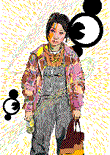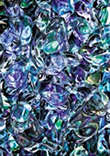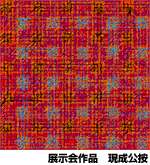Art Department
Back to Contents of Issue: August 2000
|
|
||
|
by Andrew Pothecary |
||
Digital art is becoming ubiquitous -- and predictable. As with any genre, so much of it follows a recognizable routine (3-D girls, glossy rendered surfaces, stock surrealism created with transparency and layering, otaku imaginings...). Digital Image Gallery 2000, an annual exhibit featuring 160-plus artists, indulges this ubiquitousness -- and makes room for the genre's more exceptional works. It also allows gallery presentation itself to become an element in works usually seen only on the printed or online page. (The exhibition is just one of Digital Image's activities. Set up a decade ago, the Japanese organization offers members promotion, introductions to interested companies, training opportunities, and so on.) The Gallery 2000 show is split into two Tokyo happenings: the first took place earlier this year, the second is happening this month in Omotesando.
Yukio Kuwajima's pictures (www.bitmap.co.jp/ kuwajima) have an edge to their content that pulls them out of the familiar computer art (one features a crying, bandaged baby among puri kura -- the "print club" photo stickers still popular in young Japan). They were exhibited printed on sheets of large art-pad paper that you could leaf through in the gallery. His youth-inspired theme and style -- that vacant-yet-edgy culture of contemporary Tokyo (see upper right) -- quite obviously border on those of the "Super Flat" artists, a recent grouping curated into existence by contemporary-art success Takahashi Murakami. Indeed, it seems the words pop and otaku, which were key in that show, are paramount in computer art. Both Kuwajima and Matsubara use the newer technology grounded in established illustrative modes (after all, technology without the concept or feeling is, well, just technology). But technology taking its own direction can be interesting in itself. Mitsuhiko Kotani took the now familiar android of computer graphics and worked it into abstraction (right). In this and his other work (www.kcr21.co.jp), he brings to a well-used computer graphic imagery a style and appearance that is out of the ordinary. Dip into the overload: you'll be rewarded with contemporary successes and future directions. Digital Gallery 2000, August 17-24, Gallery Nespace, Omotesando. www.digitalimage.org.
|
||
Note: The function "email this page" is currently not supported for this page.




 Among the earlier exhibitors were, for example,: Koji Matsubara (
Among the earlier exhibitors were, for example,: Koji Matsubara (


